Hack 93 Modify or Convert Batches of Documents
![]()
![]()
Automate repetitive tasks using Acrobat, such as converting folders of Word documents to PDF.
If you have a folder of PDFs that you must alter or convert, consider using Acrobat's built-in batch processing feature. After you create a batch sequence, you can use it to process large quantities of PDFs hands-free. You can also apply a batch sequence to a single PDF, which means you can create batch sequences for use as macros.
Acrobat batch processing isn't just for manipulating PDF. You can use it to convert Microsoft Office documents, PostScript files, or graphic bitmaps into PDF documents. Or, use batch processing to convert PDF documents to HTML, PostScript, RTF, text, or graphic bitmaps. Many of these options are not available in Acrobat 5. In Acrobat 6, you can also apply OCR to bitmaps or refry PDFs to prepare them for online distribution [Hack #60] .
You can automate many of the basic things you do in Acrobat with batch processing. We'll describe a couple of examples.
7.2.1 Refry a Folder Full of PDFs (Acrobat 6 Pro)
Before publishing a PDF online for wide
distribution, you should try reducing its file size by refrying it
[Hack #60] . With Acrobat 6, you
can refry a PDF using its Optimizer feature (Advanced 
Create a batch sequence in Acrobat 6 Professional by selecting
Advanced 
If you want to also add metadata (title, subject, author, or keywords) to the PDFs, click Select Commands . . . and the Edit Sequence dialog will open. Select the Description command from the list on the left and click Add. In the right column, double-click this command and a dialog opens where you can set the metadata values, shown in Figure 7-1. Click OK to close the Edit Sequence dialog and to return to the Batch Edit Sequence dialog.
Figure 7-1. Adding PDF metadata using the Description batch sequence command
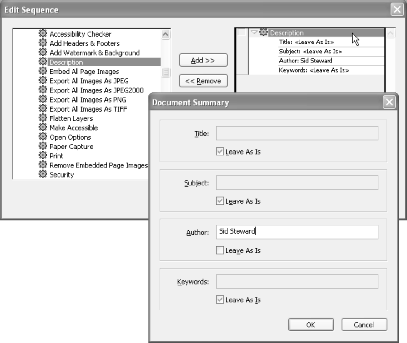
|
Set Run Commands On to Ask When Sequence is Run. Set Select Output Location to Same Folder as Original(s). Click Output Options . . . .
On the Output Options dialog, shown in Figure 7-2, select Add to Original Base Name(s) and then set Insert After to .opt. Under Output Format, set Save File As to Adobe PDF Files. Place checkmarks next to Fast Web View and PDF Optimizer. Click Settings . . . to configure the Optimizer, as shown in Figure 7-3.
Figure 7-2. The Output Options dialog, where you can access Optimizer settings
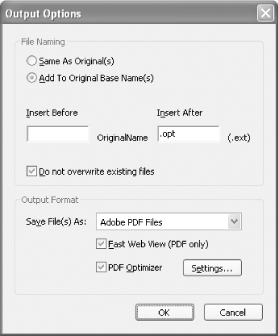
Figure 7-3. Using the PDF Optimizer to prepare your PDFs for online distribution
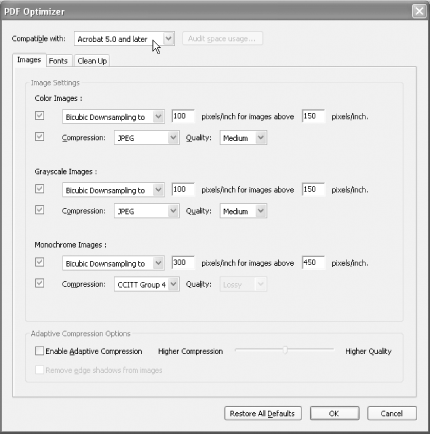
Configure the Optimizer to suit your requirements. Set its compatibility to Acrobat 5.0 and Later or Acrobat 4.0 and Later for maximum PDF portability [Hack #41] . Click OK when you're done.
Click OK to close the Output Options dialog. Click OK to close the Batch Edit Sequence dialog. Your new Refry batch sequence now should be visible in the Batch Sequences dialog, as shown in Figure 7-4.
Figure 7-4. Your new batch sequence appearing in the list
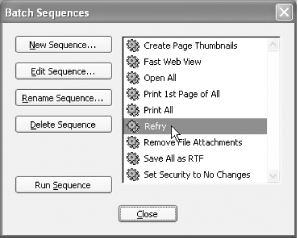
|
Test your batch sequence on a temporary folder of disposable PDFs. In the Batch Sequences dialog, select Refry and click Run Sequence. Click OK on the Confirmation dialog. A file selector will open. Select one or more PDFs and click Select to continue. Acrobat will create new PDFs based on your Optimizer settings. The new PDFs will have the same filenames as the original PDFs, except they will have .opt.pdf instead of .pdf at the end. When Acrobat is done, check the new PDFs to make sure the results are satisfactory.
|
7.2.2 Convert Microsoft Office Documents to PDF
If you have Acrobat 6 and Microsoft Word, you can use Acrobat's preconfigured Open All batch sequence to convert Word documents into PDFs hands-free. As the name suggests, you actually can use the Open All batch sequence on any kind of file that Acrobat knows how to handle, including bitmap and PostScript files. Acrobat 5 also has an Open All batch sequence, but it does not handle as many file types as Acrobat 6 does.
|
First, you must configure Acrobat 6 to create the kind of PDF you
desire. Do this using the Acrobat preferences, located at Edit



Figure 7-5. Acrobat's preferences, which control PDFs created with Acrobat
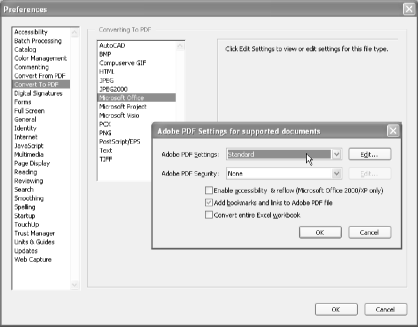
In Acrobat 6, start the Open All batch sequence by selecting Advanced




7.2.3 Exploring Batch Sequences
The previous examples are pretty simple. You can also create fancier sequences to perform specific tasks. The Acrobat 5 CD-ROM includes batch sequence examples and documentation in its Batch folder. Also, visit http://www.planetpdf.com/mainpage.asp?webpageid=1511 for more examples and commentary.
|
Batch sequences are stored as text files, so they are easy to maintain. System-level sequences are located somewhere such as C:\Program Files\Adobe\Acrobat 6.0\Acrobat\Sequences\ENU\. With Acrobat 6, user-level sequences are located somewhere such as C:\Documents and Settings\Sid Steward\Application Data\Adobe\Acrobat\6.0\Sequences\. With Acrobat 5, user-level sequences are located somewhere such as C:\Documents and Settings\Sid Steward\My Documents\Adobe\Acrobat\Sequences\.







